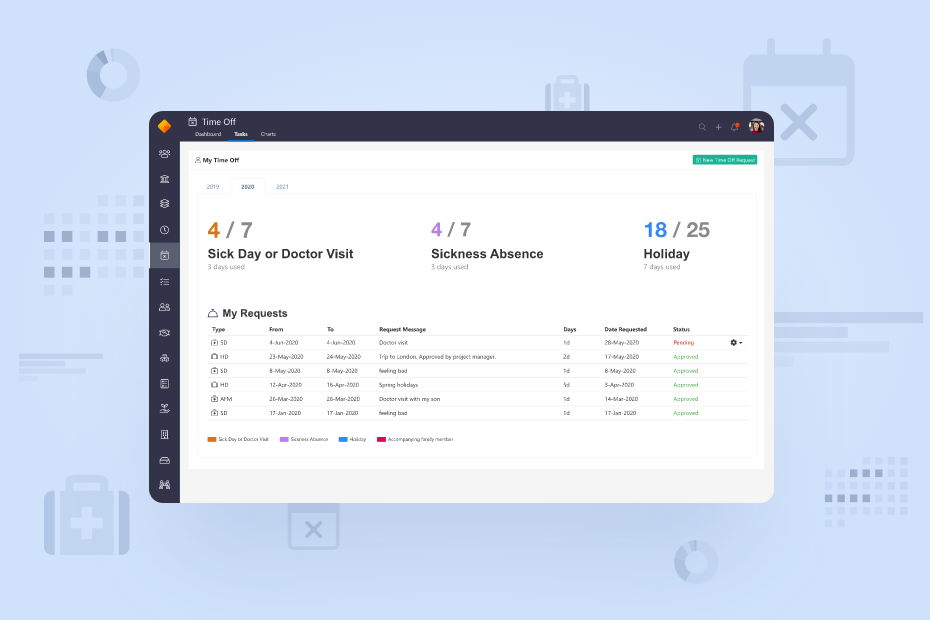
A leave management system is a designated process for managing all forms of employee time-off and leave requests in a fast and efficient way. Automating a leave management system through an online platform ensures error-free and the optimized processing of multiple and diverse leave requests at once.
What do you have to do when an employee applies for a leave request?
A leave of absence refers to the provision for employees to take a break from their professional roles for a designated period. When an employee applies for a leave request, the following steps are included when processing the request:
- Cross-checking whether the request is in accordance with the company leave of absence policy.
- Determining whether the request for leave of absence adheres to the laws and federal statutes, such as FMLA, ADA, etc.
- Identifying the specific laws that may or may not apply to the leave of absence request.
- Reviewing all the benefits that should be provided to the applicant based on their leave of absence type
- Communicating the results of the request with valid justifications to the employee
- Notifying the employee of concern about all developments and particulars for the request
- Monitoring the leave of absence duration for each case from the request submission and the decision to the end date of the leave (if granted)
- Analyzing the efficacy of the leave of absence policies overall for the company
Different types of employee leave requests
In general, leave requests are classified depending on the legal categories defined by the state and federal laws. Here are a few types of employee leave requests:
- Family and Medical Leave Act (FMLA)
- Emergency Family and Medical Leave Act (EFMLA)
- Americans with Disabilities Act (ADA)
These three types then fall under any of the following categories:
- Paid leave: Certain holidays, such as New Year’s Day or Memorial Day, are eligible for paid leave.
- Unpaid leave: Most FMLA or EFMLA leaves are unpaid and are up to 12 weeks long. However, job security and health benefits are maintained during this time.
- Mandatory leave: There are several leaves that an employer should mandatorily provide employees. These include maternity leave, paternity leave, service incentive leave, and many more.
- Voluntary leave: Any employee can take voluntary leave from work for personal reasons without losing their permanent employee status.
How does a leave management system work?
An integrated, cloud-based leave management system optimizes the tedious and time-consuming process for both the employee and HR personnel.
A consolidated platform for leave management allows employees to submit leave requests with a few clicks. An employee can then select the leave category, state the associated reasons, upload any necessary documents, and add informative notes wherever necessary. They are then notified of any developments or changes to their leave request. The information of all the leaves of an employee in a working month/year is recorded and concisely presented on this platform. The HR personnel can easily track the leave history for each employee and release the payroll in accordance.
Read on: Manage and track time offs easily
Why is a leave management system important?
As each leave request has its own specifications, manually managing leave requests often results in unforeseen errors. Moreover, manual leave management is a time-consuming task that can have a negative effect on a company’s productivity.
On the financial front, mismanagement of paid or unpaid employee leave can result in the company incurring substantial costs. Hence why it is important to have a modulated leave management system.
Benefits of using a leave management system
- Automation – A large benefit of using leave management systems as it ensures accuracy, efficiency, and integration.
- Reduced errors – An automated leave management system can reduce errors when processing requests by 90%.
- Improved productivity – Automation of the major tasks associated with leave management boosts the company’s overall productivity.
- Less paperwork – There is always a chance of misplacing important information with more paperwork. A leave management system requires less paperwork and integrates all the important information into a dashboard.
- Improved communication – A leave management system keeps all the stakeholders involved informed using timely notifications.
Read on: 8 ways Vault can help your HR department
Features of a leave management system
Here are a few features that you should be aware of from a leave management system:
- Monitors all leave requests regularly
- Tracks the timeline of each leave request case-by-case
- Cross checks employee attendance according to the leave history
- Releases accurate payrolls based on each employee's leave type (paid/unpaid)
Best leave management systems
Vault ERP
A modulated, cloud-based ERP system that uses an integrated platform to manage all leave requests. Vault ERP regularly updates related information and notifies the involved stakeholders in a timely manner.
Pocket HRMS
The attendance management software is a cloud-based solution for efficient leave management but has a disassembled module structure.
Workforce
A centralized, cloud-based leave management solution for task optimization. However, the paid time-off requests are not displayed in the balance and must be done manually.
greytHR
A web-based leave management software that promises efficiency but has a complex user interface.
ADP
A customizable, cloud-based leave management solution that lacks transparency in terms of pricing. A quote is only available after a thorough evaluation by their analysts.
Benefits of using a modular system for leave management
The integrated leave management system of Vault ERP has clearly categorized interlinked modules of information. This makes it easy to navigate and track multiple leave requests. Vault ERP also has additional modules that deal with employee recruitment and resignation. These concise and easy to use modules enable HR to manage information of the entire workforce quickly and efficiently. A modular system that automates tasks and has a dedicated team of developers for ad hoc changes is what makes Vault ERP the best investment for your company.
